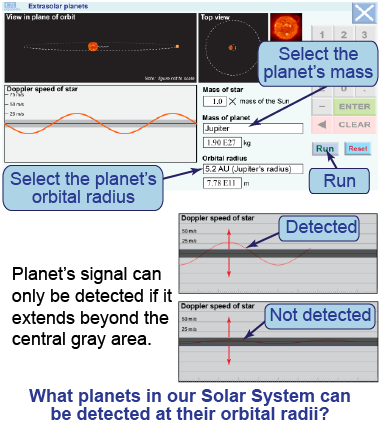| | Essential questions | | How do planets and stars influence each other’s motion?
| |
|
Are there planets around other stars? Science fiction writers have been pondering this question for many years. In the past two decades, astronomers have detected many extrasolar planets—planets around stars other than the Sun—using a Doppler technique. Astronomers detect tiny wobbles in the velocities of nearby stars in order to infer the presence of orbiting planets. Many planets discovered in this way are as massive as Jupiter but are very hot, because they orbit at very small radii from their star—closer than Venus or Mercury. Why have astronomers found so many hot Jupiters with this technique, but no Earth-like planets? 
|
Part 1: What planets in our Solar System could be detected?
 The Doppler velocity for an astronomical object is how fast it is moving toward or away from you along the line of sight. The large mass of a star will cause its planets to move around in large orbits, but the planets themselves will also cause their parent stars to wobble a little. The mutual forces form an action–reaction pair! Astronomers using the Doppler technique try to detect the component of the star’s velocity along the line of sight.
The Doppler velocity for an astronomical object is how fast it is moving toward or away from you along the line of sight. The large mass of a star will cause its planets to move around in large orbits, but the planets themselves will also cause their parent stars to wobble a little. The mutual forces form an action–reaction pair! Astronomers using the Doppler technique try to detect the component of the star’s velocity along the line of sight. - Select a planet with the mass and orbital radius of Jupiter.
- Play the orbit simulation. Can this planet be detected at this orbital radius?
- Repeat for each of the eight planets in the Solar System at that planet’s orbital radius. (You may have to research the planet’s orbital radii!) Tabulate your results.
- If you were an astronomer on another star and studying our Solar System, which planets could you detect?
- Inspect the orbital period in the upper-left graphic. If you were an astronomer, how long would you have to collect scientific data to detect Jupiter?
- Why can certain planets be detected with this technique while others cannot?

|
In this interactive simulation, you will investigate how astronomers look for the signs of extrasolar planets using the velocity of the parent star as it moves toward and away from us. The velocity of the parent star along the line of sight is a small, reflex motion in response to the gravitational pull of the planet orbiting around it.
|
Part 2: Hot Jupiters and super-Earths
- Try detecting a Jupiter-mass and “super-Earth”-mass planet (five times the mass of the Earth) at various orbital radii.
- At what orbital radii can a “super-Earth” be detected, if any?
- Do you expect this Doppler technique to reveal Earth-like planets? Why or why not?
- Why is a typical extrasolar planet discovered using this technique referred to as a “hot Jupiter”?

| |
| |
|

